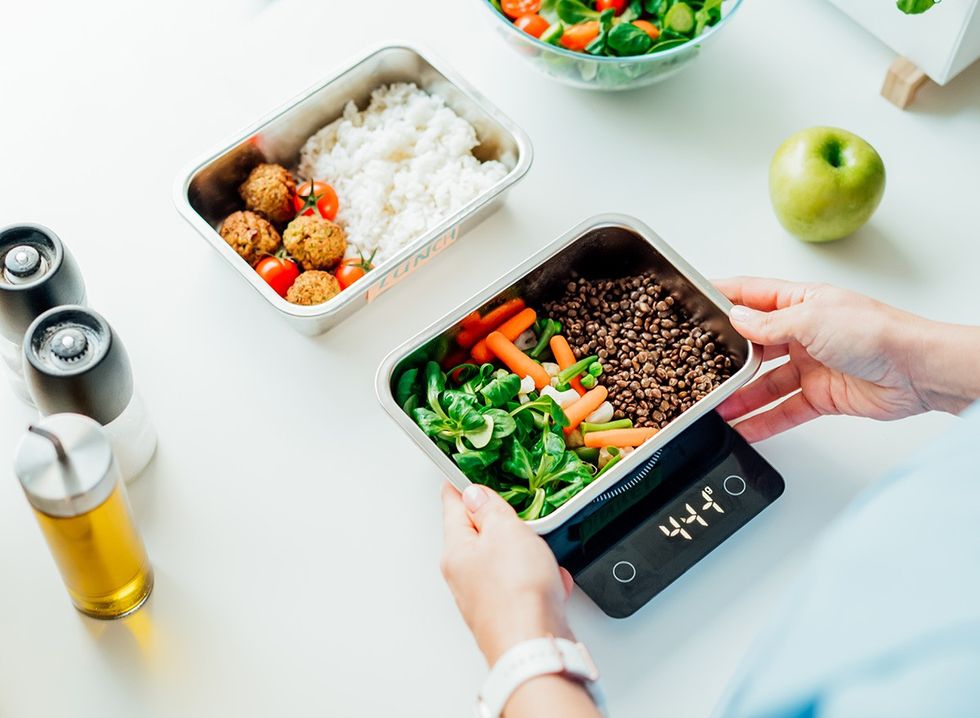Losing weight over 50 comes with its own unique set of challenges—changes to muscle mass, hormones, stress, mobility, balance, and more can make dropping a few pounds difficult. This doesn’t mean losing weight is impossible after 50, as the same rules still apply. It just means you may have to be more diligent about certain behaviors and habits. “Of course, it may not be hard for everyone to lose weight after age 50,” says Vanessa Ling, ND, CNS, via NCOA. “Weight is the sum of multiple lifestyle, social, and genetic factors, including family history, chronic diseases, medications, eating patterns, exercise habits, access to healthy food options, and the ability to prepare nutritious meals. Changing metabolism is just one piece of the puzzle to maintaining a healthy weight at any age.”
Ready to say bye-bye to that pesky stubborn fat? Here’s how to lose 15 pounds in 5 weeks and keep it off permanently.
Calorie Deficit
Shutterstock
You have to eat fewer calories than you’re burning off in order to lose weight. “If you want to lose weight with a calorie deficit, I suggest tracking what you’re currently eating before making any changes,” Beth Czerwony, RD, tells the Cleveland Clinic. “It’s good to understand your starting point.”
Walk As Much As Possible

Walking is a highly underrated and accessible method of fat-burning and exercise. “Walking can have a bigger impact on disease risk and various health conditions than just about any other remedy that’s readily available to you,” says Harvard Health. “What’s more, it’s free and has practically no negative side effects. Walking for 2.5 hours a week—that’s just 21 minutes a day—can cut your risk of heart disease by 30%. In addition, this do-anywhere, no-equipment-required activity has also been shown to reduce the risk of diabetes and cancer, lower blood pressure and cholesterol, and keep you mentally sharp.”
Eat Protein

Studies show you may lose muscle mass at a rate of 8% per decade after 40. One reason is that eating enough good quality protein is a must for weight loss and a healthy diet. "Muscles have a profound effect on our health, affecting everything from mobility, balance, posture, and even strength and energy," Jacqueline Boff, PhD, MBA, research scientist, tells Abbott Nutrition News. "The good news is you can slow age-related muscle loss by getting the right amount and the right kinds of protein along with exercise to rebuild muscle.”
RELATED:I Got Into the Best Shape of My Life at 50 by Following These 6 "Basics"
Lift Weights

Lifting weights is one of the most beneficial things you can do after 50, both for weight loss and overall health and fitness. “Muscle is more metabolically active — it burns more calories than fat,” William Yancy Jr, MD, director of the Duke Lifestyle and Weight Management Center in Durham, North Carolina, tells AARP. “So having a higher ratio of muscle to fat will mean you burn more energy — just while sitting. To build that muscle, you have to exercise, and that burns calories, too.”
Make Sleep a Priority

Aim for 7 hours of sleep every night. “As we age, our sleep patterns change, too,” Ling says. “Older adults tend to take longer to fall asleep, wake up more frequently through the night, and may also sleep for fewer hours. Getting adequate and restful sleep might not seem like a weight loss strategy, but better sleep can actually help with weight loss. Poor-quality sleep or sleep deprivation can hinder digestion, metabolism, mental health, and other normal body functions.”
Manage Stress

Manage stress through methods like therapy and exercise. “The relationship between mental health and weight goes both ways,” Ling says. “Mental health conditions like depression can lead to higher weight, while higher weight can contribute to poorer mental health. For example, weight bias and discrimination can result in weaker social support and social isolation that can negatively impact mental health.”
RELATED:I'm 50+, and These 7 Fat-Blasting Habits Keep Me in the Best Shape of My Life
Move Throughout the Day

Make it a point to move as much as possible throughout the day. “Standing while working, walking or biking to work, parking farther from the building, taking the stairs, doing household chores, spending time out in the garden, playing with your dog at the park, or even getting up during commercials or series episodes to move around,” registered dietitian Alex Oskian tells NCOA.
Use a Nutritionist

Consider using the services of a professional to come up with a good eating plan. “There’s so much misinformation and so many mixed messages out there,” registered dietitian Tegan Bissell, RD, LDN, CDCES, tells the Cleveland Clinic. “As experts in food and nutrition, dietitians can help you sift through it all and point you to the science.”
No Screens At Bedtime

Avoid disruptive screen time before bed. “Checking your phone stimulates your brain,” sleep medicine expert Michelle Drerup, PsyD, DBSM, tells the Cleveland Clinic. “You’re more active and awake. Even just a quick check can engage your brain and delay sleep.”
RELATED:I Hit 60, and These Daily Habits Keep Me Fit and Feeling 20 Years Younger
Sustainable Changes

Remember, this is not a fad diet—it’s a long-term change. “You’re not just losing pounds—you’re gaining life,” Phyllis Pobee, MD, family medicine physician in Toronto, Ontario, Canada, tells NCOA. “Focus on sustainable changes that celebrate your body. Small, consistent tweaks over time can lead to remarkable transformations.” And if you enjoyed this article, take advantage of these 20 Superfoods for People Over 50.





















 I'm a Nutritionist and These 9 High-Protein Snacks Keep My Clients Full While Losing 50 Pounds
I'm a Nutritionist and These 9 High-Protein Snacks Keep My Clients Full While Losing 50 Pounds
 Shutterstock
Shutterstock 2. Processed FoodsShutterstock
2. Processed FoodsShutterstock Shutterstock
Shutterstock Shutterstock/Prostock-studio
Shutterstock/Prostock-studio Shutterstock
Shutterstock Pro TipsShutterstock
Pro TipsShutterstock Shutterstock
Shutterstock Shutterstock
Shutterstock Shutterstock
Shutterstock Shutterstock
Shutterstock Don’t Drink as Much AlcoholShutterstock
Don’t Drink as Much AlcoholShutterstock Most Women on GLP-1s Are Making a Few Common MistakesShutterstock
Most Women on GLP-1s Are Making a Few Common MistakesShutterstock Soda and Sugary DrinksShutterstock
Soda and Sugary DrinksShutterstock Shutterstock
Shutterstock Eat BreakfastShutterstock
Eat BreakfastShutterstock And Improve Insulin SensitivityShutterstock
And Improve Insulin SensitivityShutterstock Belly Flab Strip Tip: Sugar and Fat Calories Leave Its Mark on Your BodyShutterstock
Belly Flab Strip Tip: Sugar and Fat Calories Leave Its Mark on Your BodyShutterstock Shutterstock
Shutterstock The Drugs Mimic the GLP-1 Hormone Naturally Produced by the BodyShutterstock
The Drugs Mimic the GLP-1 Hormone Naturally Produced by the BodyShutterstock 3. Deep-Fried ItemsShutterstock
3. Deep-Fried ItemsShutterstock